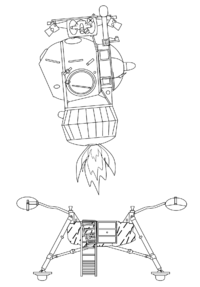Soyuz 2
Soyuz 2 (Russian: Союз 2, Union 2) was an uncrewed spacecraft in the Soyuz family intended to be the target of a docking maneuver by the manned Soyuz 3 spacecraft. It was intended to be the first docking of a manned spacecraft in the Soviet space program. Although the two craft approached closely, the docking did not take place and the first successful Soviet docking of manned spacecraft took place in the joint Soyuz 4 and Soyuz 5 mission.
| Mission type | Test flight |
|---|---|
| Operator | Soviet space program |
| COSPAR ID | 1968-093A |
| SATCAT no. | 3511 |
| Orbits completed | 48 |
| Spacecraft properties | |
| Spacecraft type | Soyuz 7K-OK |
| Manufacturer | Experimental Design Bureau OKB-1 |
| Launch mass | 6,450 kilograms (14,220 lb) |
| Start of mission | |
| Launch date | October 25, 1968, 09:00 UTC |
| Rocket | Soyuz |
| Launch site | Baikonur 1/5[1] |
| End of mission | |
| Landing date | October 28, 1968, 07:51 UTC; |
| Orbital parameters | |
| Reference system | Geocentric |
| Regime | Low Earth |
| Perigee altitude | 191 kilometres (119 mi) |
| Apogee altitude | 229 kilometres (142 mi) |
| Inclination | 51.70 degrees |
| Period | 88.60 minutes |
Mission parameters
- Mass: 6,450 kg (14,220 lb)
- Perigee: 191 km (119 mi)
- Apogee: 229 km (142 mi)
- Inclination: 51.70°
- Period: 88.60 min
"Crew" hoax
Conceptual artist Joan Fontcuberta claimed in 1997 that Soyuz 2 was manned by Ivan Istochnikov and a dog named Kloka, who disappeared on October 26, 1968, with signs of having been hit by a meteorite. According to Fontcuberta, Soviet officials deleted Istochnikov from official Soviet history to avoid embarrassment; however, the "Sputnik Foundation" discovered Istochnikov's "voice transcriptions, videos, original annotations, some of his personal effects, and photographs taken throughout his lifetime." The exhibition of artifacts (e.g., photographs) related to "Soyuz 2" was shown in many countries, including Spain, France, Portugal, Italy, Mexico, Japan, and the United States.[2][3] Among other reactions to the exhibition, a Russian ambassador "got extremely angry because [Fontcuberta] was insulting the glorious Russian past and threatened to present a diplomatic complaint."
Several lines of evidence available since the first exhibition of "Sputnik" in 1997 in Madrid suggested that the story and artifacts form an elaborate hoax:
- The name "Ivan Istochnikov" is a Russian translation of Joan Fontcuberta's name; in specific, "Joan" and "Ivan" both translate to "John"[4][5] and "Fontcuberta" and "Istochnikov" both mean "hidden fountain."
- The photographs of Istochnikov show Fontcuberta's face.
- Pages of the official Web site of the Madrid exhibition contain the words "PURE FICTION" toward the top of each page in light red text on a dark red background[6] or light pink text on a white background.[7]
- The front and rear endpapers of the catalog accompanying the Madrid exhibition have the words "it's all fiction" in Russian and Spanish printed on them using glow-in-the-dark ink.[8]
- At the Web site of Spanish newspaper El Mundo, the third of three pages concerning the Madrid exhibition states that "the report which we published on the previous pages is a product of his [Fontcuberta's] imagination."[2]
References
- "Baikonur LC1". Encyclopedia Astronautica. Archived from the original on 2009-04-15. Retrieved 2009-03-04.
- Pérez de Albéniz, Javier. El cosmonauta fantasma. El Mundo magazine, 25 May 1997. Retrieved 1 July 2008.
- Curtis, Mary Jo. Artists mix fact and fantasy in False Witness exhibition at Bell Gallery. Providence, Rhode Island: Brown University, 17 January 2001. Retrieved 1 July 2008.
- English Catalan Dictionary. Retrieved 1 July 2008.
- Online Etymology Dictionary: Ivan. Retrieved 1 July 2008.
- Sputnik Foundation. Archived 5 June 2008 at the Wayback Machine "From May 21st to July 20th, 1997." Retrieved 1 July 2008.
- Texts from the SPUTNIK catalog. Archived 21 August 2008 at the Wayback Machine Retrieved 1 July 2008.
- Kondakova, Olga, et al. Sputnik. Madrid: Fundación Arte y Tecnologia, 1997. ISBN 84-89884-00-5.
Further reading
- Luna Cornea, Number 14, January/April 1998, p. 58,
- The Fabricated Cosmonaut and the Nonexistent Prophecy, Luis Alfonso Gamez. Skeptical Inquirer Volume 30, number 5 (September/October 2006) p12.
External links
- Brown University News Service Artists mix fact and fantasy in False Witness exhibition at Bell Gallery.

